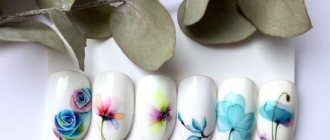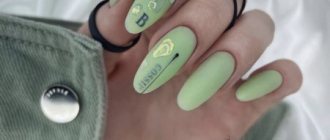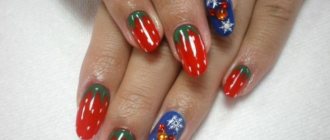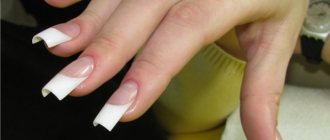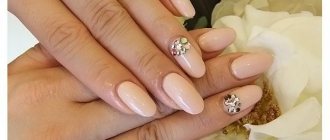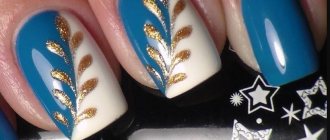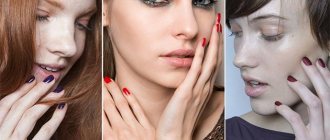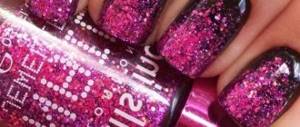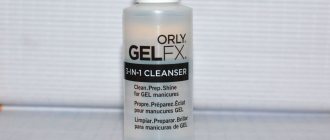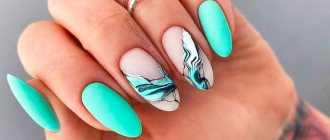Silicone brush - one tool, many tasks.
A silicone brush, also called a shaper, is not in every master’s pencil case, and in vain.
This tool has a number of obvious advantages: 1. The material from which the brush is made is much more durable compared to the brushes we are used to.
2. Silicone tips are easy to clean. And even if you forget to clean the material and it dries out, it will not ruin the brush. But it is important to understand that they cannot be sterilized.
3. They are very economical in consumption, because... do not absorb material.
4. They do not create air bubbles in the material and do not accumulate dust particles, which is especially important when working with transparent gels.
But the most important advantage is their versatility. We will tell you in the review what specific tasks can be solved with silicone brushes.
As already mentioned, silicone, unlike bristles, does not fill the material with air bubbles, so performing extensions with transparent gel becomes a much simpler task as soon as you start using the shaper.
The following attachments are especially convenient for extensions:
1. A flat brush is ideal for nail modeling. The wide surface allows you to spread the gel, and the tapered tip is ideal for working in the side roller area.
2. The spoon-shaped nozzle holds a drop of gel on itself, i.e. It is easy to pick it up with this type of brush and apply it to the nail.
3. A hoof-shaped brush is used to create a neat smile line.
The photo demonstrates how much better the gel is applied with a silicone brush: even in an enlarged format, virtually no bubbles are visible, and the transparent gel looks perfect to the naked eye.
You can read more about the 4D gel sculpting process in one of the earlier tutorials.
What is important to understand: each brush shape will leave its own mark, which means it will expand your design possibilities. One will smooth out the shape, the other will add edges. Leaving marks on plasticine can create an interesting texture.
When working with rubs, silicone brushes are indispensable. Only a tool with a plastic, smooth surface can create a mirror effect on your nails. You can learn more about working with rubs in the review, which talks about the types of rubs and application technology.
These properties of silicone should also be used when working with other materials for nail design: stickers, sliders, foil. The foil often does not come off easily from the sticky layer or glue, coming off in pieces, but if you smooth it out with a brush, it will come off neatly. Likewise, sliders and stickers will look much more beautiful if you work on them with a brush.
And while a master’s hand may already be trained enough to effortlessly cope with these tasks and other tools, then for a beginner every detail is important - anything can cause failure, so we recommend that those who do manicures pay attention to silicone brushes. at home.
The working process. Increased efficiency
These brushes are good not only as a leading tool, but also for performing interior work:
Painting with a silicone brush turned out to be a very exciting process. This is a much freer painting than, for example, drawing monograms. In any case, the stroke turns out to be non-uniform: somewhere the paint thickens, forming a thickening, somewhere it goes to light, being erased by the pressure of the brush. At first, everything looks completely unpredictable, but once you get used to it, you can start drawing not only abstract compositions, but also various interesting patterns and images.
The most important thing for solving a specific problem is to choose a brush of the right size and shape.
Source
What patterns can you make?
Having brushes of various sizes and shapes in your arsenal, you can create unique and delightful fantasy designs. To learn artistic painting, you need to start with simple lines, and then connect them into an overall composition. As soon as the hand moves confidently, you can move on to a more original and complex pattern.
Using a petal brush, Chinese painting is done on the nails. This technique represents plant motifs: twigs, flowers and trees. It uses various techniques, such as wave, aqua, openwork, smooth surface. The result looks original and very romantic on the nails.
A flat brush is used to create an ombre effect on nails, in which one shade smoothly transitions into another. To do this, you need to add several different colors to the palette. You can also create a gradient effect on your nails using a sponge. This nail design is suitable not only for every day, but also for special occasions.
A thin brush ideally draws out the smile line for a French manicure. This elegant design can be made in any color. At the same time, the nails look very stylish.
The most convenient way to cover your nails with glitter is to use a fan brush. The desired area is pre-treated with colorless varnish. Before it dries, you can distribute the glitter by scattering it from a fan brush onto the nail. To remove excess, use a cotton swab.
Depending on the thickness and length of the pile, you can get all kinds of patterns. A thin brush with bristles of more than 10 mm allows you to create long, neat lines in your drawing. More often, tools with a pile thickness of 7 to 10 mm are used. They can create wave-like patterns on your nails. Branches and ornaments are made with a brush 3 to 7 mm thick.
Thread tassels are a beautiful decoration that is used in various types of decoration. These include knitted hats and scarves, trim or ropes for curtains, piping for blankets or bedspreads. Tassels are used to decorate the clasps of bags and purses, and to make earrings and beads. The material used for production is also different. These include thin sewing threads, thick woolen threads for knitting, leather strips and thin twisted ropes. In this article we will look at how to make a tassel from threads.
The purpose of a silicone brush for nail design
Beginning manicurists, when first learning how to create nail designs, are concerned with the question of what silicone nail brushes are for.
They are applicable both when working with gel textures and acrylic. With their help, three-dimensional shapes are modeled and nail designs are created. Since they are of medium hardness, but quite elastic, they are used in drawing a classic French manicure, as well as in creating “holes” on the nail. Despite the fact that silicone brushes are not chosen by professionals as often as brushes made from natural or synthetic materials, many beginners should take a closer look at them, since they are easy to design nails and draw small elements. Gel, acrylic and varnish do not spread on their surfaces, which allows you to slowly and painstakingly draw a pattern or give shape to volumetric elements.
A special feature of this type of brush is its durability. They will serve a person for many years: their service life is many times longer than the possible period of using this type of tools made from natural materials.
With their help you can squeeze out acrylic parts created during sculpting. They allow beginners to experiment at first and use new techniques. In addition to creating patterns and sculpting, silicone brushes can be used to rub in pigments, smooth out decor, wipe off excess liquid material, and place rhinestones on the nail.
What will help solve the problem with choice
Sometimes it’s difficult to quickly decide which brushes you want to use and which design to choose. Photos of ready-made designer manicures applied to nails can come to the rescue. The one you like best will tell you which brushes from the set to take for the job.
Often, for greater ease, photos of manicure brushes are also placed along with photographs of manicure design. Such information is available in abundance on the Internet.
After looking through it, it is much easier to come to a final decision on how to design your nails and which tools to use.
Shapes and hardness of brushes
There are several types of silicone brushes, which differ in their shape, size, hardness and handle material. However, the main role in the work of a silicone brush, in addition to the professionalism of the manicurist, is played by its rigidity and shape. There are three types of hardness: hard, soft and medium. In most cases, hard brushes are used to create designs; soft brushes are almost never used, as they are ineffective in this work.
Silicone nail modeling brushes have the following shapes:
Silicone manicure tools are also sold in sets, which often include five brushes of different shapes. Their diameter can vary from 8 to 12 mm at the base, the length of the handle is usually 13-15 cm, and the size of the silicate itself is 22 mm. They can also be purchased each separately.
How to use a silicone nail brush?
To use silicone brushes, you need to know some safety rules:
However, silicone modeling tools have a number of important features:
These characteristics determine the rules for how to use a silicone nail brush.
The manicurist removes excess applied material using a wide brush over the surface of the gel. Thin, pointed tools should be used in the area near the rollers, removing excess. They also create the smile lines of the jacket and patterns.
Manicure tools with a wide base allow you to apply and carefully distribute thick gel and acrylic, while with a narrow base you can do this work with varnishes.
To ensure that the work of creating nail designs brings not only financial benefit to the masters, but also aesthetic pleasure, manufacturers create beautiful tools with interesting designs and decorative elements. Instruments with rhinestones, patterns and designs have become especially popular. You can purchase models with a wooden or plastic handle; the characteristics of the future working tool directly depend on the individual preferences of the person.
Thus, silicone manicure tools for modeling are distinguished by the presence of elastic rubber instead of artificial or natural bristles. It does not become clogged with gel, acrylic or varnish, and is easier to clean and wash. It does not leave lint, is durable and quite practical.
Source
How to do it at home?
To practice patterns and small details, beginners can make a nail design tool from a regular watercolor brush. This is easy to do yourself at home, with only a brush and tongs.
Using manicure tongs, carefully remove small tufts of fibers from the very base of the brush from the edge to the center. You need to try to ensure that as a result the brush is in the middle and does not move to one side. Trim the pile in small sections to avoid damaging the instrument. The number of fibers to be cut is determined by the required size of the future tool.
A good, inexpensive paint brush can be converted into a tool of the desired design and size. Caring for it is the same as for a specialized manicure brush.
It is important to remember to treat the instrument with care so that it lasts as long as possible.
Manicure brushes - which ones are intended for what?
Brushes are an integral part of manicure and a mandatory attribute of every master. They are intended not only to create an interesting, unusual design. They are used to model the shape of nails during extensions; they can be used to apply gel polish and acrylic. The display cases are replete with a variety of brushes: they differ in material, shape, and thickness. How not to get lost in all this diversity? What is each brush for? Let's figure it out.
Types of brushes: material, thickness, functionality
A variety of brushes for manicure
Based on material, brushes are divided into natural, synthetic or nylon, mixed.
Natural bristle brushes are the most expensive. The bristle has a porous structure, thanks to which the material stays on the brush longer and falls more slowly onto the drawing. Therefore, natural brushes are convenient for shading, painting watercolors, applying shadows and creating a drawing at a slow pace. The downside of such brushes is that they quickly deteriorate when exposed to acetone-based products.
The bristles of synthetic or nylon brushes, on the contrary, are smooth. The material does not stay on it for long. When applying a design to the nail plate, the material quickly flows off the brush and leaves a mark. Synthetic brushes are ideal for applying lines and patterns with gel paints.
Mixed brushes contain both natural and synthetic bristles.
Each brush must indicate what material it is made of.
Synthetic brush
The next criterion is the thickness of the bristles.
To create drawings with large elements, you will need a thick brush, and for graceful lines and patterns, a thin one. Each brush has a specific number, which depends on the thickness of the bristles. The thinnest brushes are designated 0, 00, 000, and the thickest are designated 8. That is, the thicker the brush, the higher the number.
According to their functional purpose, brushes are divided into the following categories:
Gel polish brushes. Don't like the brush that comes with the gel polish bottle? Then, to apply artificial coating, you can buy a separate brush, choosing a convenient thickness and length of the beam.
Acrylic brushes. Acrylic brushes consist of hard bristles and have a pointed end. They are convenient for laying out acrylic.
Gel brushes. Flat gel brushes have a square or rectangular shape and consist of hard bristles.
Gel brush
Types of brushes by shape
At first glance, it may seem that there are a huge number of brush shapes available in stores. But in reality there are not many of them. Let's understand the basic forms and functions they perform.
Spot brush.
The smallest brush, the size of which varies from 000 to 2. Its shape resembles a pike. Ideal for drawing the smallest details of a drawing. While working, the brush must be held vertically to the nail plate and only its tip should be dipped into the paint.
Hair, striper or liner.
For stypers (liners), the thickness of the pile does not exceed 2 mm, the length of the dome is 2-3 cm. The brush is designed for drawing thin lines.
She is comfortable making patterns, geometry, and lace. Suitable for working with gel polishes and acrylic paints. Keep in mind that it takes experience to use this brush confidently. Nail design brushes
Petal. The dome of the petal brush is flat and tapered towards the end, so the shape resembles a petal. Most often, this brush is used to create Chinese paintings with floral patterns. Also, if you have experience, you can use it to replace dotted or beveled brushes and create complex patterns, waves, and apply glitter.
Fan brush. A case where the name speaks for itself.
A fan brush has the shape of a fan, as its bristles spread out in a semicircle. With this brush you can sprinkle sparkles on the nail plate, apply glitter, shade the design, and blur the background. It is also great for creating ombre and gradient manicures. Fan brush
A flat or wide brush. The brush is suitable for beginners to practice the technique. The wide working surface allows you to evenly apply artificial coating to your nails. With this brush you can pick up several colors at once and create a complex pattern. The flat brush is also suitable for creating gradients and ombres.
Angled brush. A flat brush, the angle of which is cut at 45 degrees. It is convenient for her to create identical decorative elements, create three-dimensional images, subtle patterns, and diagonal lines on the nail. An angled brush is suitable for creating a French manicure. You can also use it to select several colors and create a complex design.
Angled brush
Rounded brush. Similar to a broad brush, but with rounded edges.
Excellent for applying gel polish, you can also create designs with it. For example, with just one stroke of this brush you can create the perfect petal for a flower. Dots
How to choose brushes for a beginner?
Is there a need to buy all types of brushes at once? Of course not. Buy those that are necessary at this stage of life and buy additional ones as you master new techniques. What to look for when choosing a brush?
How to care for brushes and store them?
Care and storage will help extend the life of your brushes. And to do it correctly, remember a few simple recommendations.
High-quality brushes are a must-have tool for every craftsman. With their help you can create any design and add zest to your manicure. And to become a real professional in this matter and realize any ideas of your clients, come to the courses at the ParisNai l school!
Source
BRUSH CARE
In order for your brushes to serve you for a long time, you need to take proper care of them.
- Do not leave gel polishes or other materials on your brushes. Clean your tools immediately after use.
- Use special products to clean acrylic brushes: they do not damage the bristles structure and allow you to keep the brushes in their original form for a long time.
- It is not recommended to dry brushes in a vertical position. This can ruin both the handle and the shape of the brush.
- Store brushes in a dark place to avoid fading and polymerization of microparticles on their surface.
The purpose of a silicone brush for nail design
Beginning manicurists, when first learning how to create nail designs, are concerned with the question of what silicone nail brushes are for.
They are applicable both when working with gel textures and acrylic. With their help, three-dimensional shapes are modeled and nail designs are created. Since they are of medium hardness, but quite elastic, they are used in drawing a classic French manicure, as well as in creating “holes” on the nail. Despite the fact that silicone brushes are not chosen by professionals as often as brushes made from natural or synthetic materials, many beginners should take a closer look at them, since they are easy to design nails and draw small elements. Gel, acrylic and varnish do not spread on their surfaces, which allows you to slowly and painstakingly draw a pattern or give shape to volumetric elements.
A special feature of this type of brush is its durability. They will serve a person for many years: their service life is many times longer than the possible period of using this type of tools made from natural materials.
With their help you can squeeze out acrylic parts created during sculpting. They allow beginners to experiment at first and use new techniques. In addition to creating patterns and sculpting, silicone brushes can be used to rub in pigments, smooth out decor, wipe off excess liquid material, and place rhinestones on the nail.
Which material to choose?
It can be difficult for beginners in nail art to decide on the material from which manicure brushes are made. It can be natural or synthetic. The final result depends on its features.
The material for making natural brushes is usually sable wool or kolinsky.
The bristles of these brushes are of high quality. They do not require special care, but will last a long time. With such tools it is convenient to draw patterns of varying complexity using different types of paints.
The polymer material from which synthetic manicure devices are made significantly reduces their cost. These brushes hold the polish well and do not allow it to bleed.
The main advantage of silicone brushes is their durability. At this point they are superior even to natural hair instruments. These brushes are convenient for applying small details.
Professional craftsmen prefer devices made from natural fibers. They appreciate their dense structure, moderate rigidity and long service life.
In order for the tool to last as long as possible, it needs to be properly cared for. Manicure brushes should be used exclusively for nail design. You should not draw with them on paper, so as not to deform the pile. When using regular paint instead of varnish, hairs often fall out.
Not only does keeping a brush in water for a long time lead to a change in its shape, but even a short period of time will lead to the loss of the original appearance of the bristles. You can return it by holding the brush in hot water for several minutes.
To prevent the varnish from drying out on the bristles of the brush, they should be washed immediately after use. If you do not do this in time, you will need acetone to clean them, which damages the structure of the fibers. The bristle of the brush will wear off very quickly when using a palette with an uneven surface. To avoid this result, do not rub the instrument with force on a napkin.
To extend the life of the tool, cuticle oil should be applied to it at the end of the procedure. Only well-dried brushes can be placed in the storage case. Exposure to the hot air of a hair dryer will be detrimental to the lint of instruments.
How to use a silicone nail art brush
At the moment there are a large number of different types of brushes. They differ in production material, creation technology, and parameters. Their characteristics influence their purpose. Silicone brushes have become widespread due to a number of significant qualities and features.
The purpose of a silicone brush for nail design
Beginning manicurists, when first learning how to create nail designs, are concerned with the question of what silicone nail brushes are for. They are applicable both when working with gel textures and acrylic. With their help, three-dimensional shapes are modeled and nail designs are created. Since they are of medium hardness, but quite elastic, they are used in drawing a classic French manicure, as well as in creating “holes” on the nail.
Despite the fact that silicone brushes are not chosen by professionals as often as brushes made from natural or synthetic materials, many beginners should take a closer look at them, since they are easy to design nails and draw small elements. Gel, acrylic and varnish do not spread on their surfaces, which allows you to slowly and painstakingly draw a pattern or give shape to volumetric elements.
A special feature of this type of brush is its durability. They will serve a person for many years: their service life is many times longer than the possible period of using this type of tools made from natural materials.
With their help you can squeeze out acrylic parts created during sculpting. They allow beginners to experiment at first and use new techniques. In addition to creating patterns and sculpting, silicone brushes can be used to rub in pigments, smooth out decor, wipe off excess liquid material, and place rhinestones on the nail.
Shapes and hardness of brushes
There are several types of silicone brushes, which differ in their shape, size, hardness and handle material. However, the main role in the work of a silicone brush, in addition to the professionalism of the manicurist, is played by its rigidity and shape. There are three types of hardness: hard, soft and medium. In most cases, hard brushes are used to create designs; soft brushes are almost never used, as they are ineffective in this work.
Silicone nail modeling brushes have the following shapes:
Silicone manicure tools are also sold in sets, which often include five brushes of different shapes. Their diameter can vary from 8 to 12 mm at the base, the length of the handle is usually 13-15 cm, and the size of the silicate itself is 22 mm. They can also be purchased each separately.
How to use a silicone nail brush?
To use silicone brushes, you need to know some safety rules:
However, silicone modeling tools have a number of important features:
These characteristics determine the rules for how to use a silicone nail brush.
The manicurist removes excess applied material using a wide brush over the surface of the gel. Thin, pointed tools should be used in the area near the rollers, removing excess. They also create the smile lines of the jacket and patterns.
Manicure tools with a wide base allow you to apply and carefully distribute thick gel and acrylic, while with a narrow base you can do this work with varnishes.
To ensure that the work of creating nail designs brings not only financial benefit to the masters, but also aesthetic pleasure, manufacturers create beautiful tools with interesting designs and decorative elements. Instruments with rhinestones, patterns and designs have become especially popular. You can purchase models with a wooden or plastic handle; the characteristics of the future working tool directly depend on the individual preferences of the person.
Thus, silicone manicure tools for modeling are distinguished by the presence of elastic rubber instead of artificial or natural bristles. It does not become clogged with gel, acrylic or varnish, and is easier to clean and wash. It does not leave lint, is durable and quite practical.
Stages of work during gel extensions
If we highlight the stages of work, they develop in the following chronology: The first stage is disinfection and removal of the cuticle. The second step is to polish the nail in order to ensure maximum adhesion of the gel to the nail plate. The third stage is the application of primer. The next, fourth stage is the direct application of the gel and the formation of an artificial nail. After almost every stage, it is necessary to carry out the procedure of drying nails under ultraviolet light. This not only promotes good drying and rapid hardening of the material, but also has a good antibacterial effect. To apply the gel, brushes are exactly what you need. Let's look at which one is needed for what purpose in more detail.
Types of manicure brushes
Depending on the material from which they are made, nail design brushes can be:
The most expensive and high-quality brushes are natural ones, but they are quickly spoiled by products containing acetone. In addition, they are difficult to wash off from varnish and gel.
Brushes are also divided according to their purpose:
Each brush has a number indicating its thickness or width (for flat brushes). The thinnest are marked 00 and 0, the thickest are marked with the number 8, respectively, the larger the number on the handle, the thicker (wider) the instrument.
Nail Spot Brush
To create various designs, special brushes are used for painting on nails, differing in shape, length and bristle stiffness. Thus, the dotting brush has a round shape and short, thin bristles. Its size is the smallest - from 000 to 2. With such brushes it is easy to draw the smallest details of a complex lace pattern or emphasize individual elements.
Fan brush for manicure
A fan brush has bristles directed in all directions, like an open fan. It is convenient for shading floral designs, applying glitter and sparkles: first, the desired area is covered with colorless varnish, and sparkles are carefully scattered on top with a fan brush.
Petal brush for nail design
Thin petal brushes designed for painting nails have a beveled edge and a flat shape. They are convenient for making light strokes, applying glitter, and creating original patterns and ethnic ornaments.
This brush is often used for Chinese painting with characteristic plant motifs - flowers, stems and trees. With a petal brush it is easy to draw specific techniques characteristic of this technique - waves, openwork, smooth surface. The result is a very delicate and romantic design.
brush hair
Hair - a thin brush for nail design, round in shape, often with long bristles. It is very convenient to draw long, straight lines. Depending on the task at hand, you can choose a nail liner brush with bristles of different lengths. Such products are practical and often used by manicurists.
Flat manicure brush
A flat, wide brush allows you to quickly and evenly coat the nail plate with varnish. You can also use it to create a gradient and implement other interesting and non-standard nail art techniques.
Rounded nail brush
A rounded brush with sharp edges is best suited for applying gel polish and sculpting. It is similar in size to a thick brush, but its bristles are oval-shaped. She creates stylish designs of different sizes, for example, flowers, because just one imprint of a rounded brush leaves a perfect petal.
Dagger-shaped manicure brush
Dagger-shaped brushes for nail design are flat, with a smoothly rounded end. They are suitable for simultaneously applying different colors of varnish and drawing elegant, three-dimensional patterns.
Thick manicure brush
A thick brush is suitable for uniformly applying varnish over the entire nail plate, as well as drawing large strokes and wide stripes, processing the contours of large elements and creating three-dimensional patterns. The bristles of thick brushes are straight and flat - this allows you to simultaneously pick up several shades of varnish and draw patterns with multi-colored paint.
Although dots are actually a stick, they are usually also classified as thin brushes for painting on nails. By applying varnish to the rounded tip of a dot, you can create designs of any complexity - from simple dots to skillful Gzhel painting.
Shapes of brushes
You can work with acrylic with a tool of any shape, but each of the brushes is capable of performing a certain amount of work while painting. It is very easy to ruin a painting if you choose the wrong brush shape for certain strokes.
- Round. This tool is considered universal, suitable for any paints and techniques. They can be used for drawing details or filling, depending on the number of the brush. The round shape is achieved by enclosing the pile in a round-shaped cage.
- Flat. To create this brush shape, a flat clip is used. Brushes can be wide and narrow, long and short. They are convenient to use for painting large areas of a painting with plain paint, including acrylic.
- Contour. The shape of these brushes is similar to flat brushes, but the bristles are shorter and wider, making strokes easier to control. Contour brushes are also convenient for creating color transitions when painting.
- Brush in the shape of a cat's tongue. The shape of such an instrument resembles a dome or oval. It is considered a compromise solution between round and flat brushes, since it leaves different strokes depending on the position. The tool is not suitable for beginners, as its use requires some skill.
- Linear. To create such a brush, long bristles are used, and the thickness of the tool is very small. The brush is more suitable for inscriptions or very thin, small details.
Types of manicure brushes: which one is for what?
Rounded. This brush is similar to a wide one, but has a slightly different shape. The tool has a rounded tip, which makes it easier to apply liquid varnishes. Material: natural pile.
Types of tools for manicure at home: https://medvoice.ru/chto-nuzhno-dlya-manikyura/
Tips for beginners on choosing a tool for work
Methods for removing shellac at home: https://medvoice.ru/sposobyi-snyatiya-shellaka-v-domashnih-usloviyah/
What brushes are needed for manicure: fluffy classification
If you go to the store unprepared, the variety of brushes can easily confuse you. Different thickness and shape, price category, how to figure it out?
The first classification is by purpose. Simply put, there are tools for extensions, and there are tools for nail art. So, if you just want to practice with non-trivial patterns, then the range of choices narrows.
Otherwise, brushes are divided according to three criteria:
Peculiarities
Manicure brushes differ from those analogues that are used for painting on paper or canvas. Their working part may consist of different materials; softness and elasticity will depend on this. The bristles can be natural or artificial; in addition, the shape of the brush may differ, which will determine the type of its use. With proper care, each such tool can serve the master for at least two years.
We don't think about the fact that all the brushes used by nail professionals have their own purpose. Some of them are used directly for design and creating a specific pattern. Options of natural origin, designed to work with acrylic nail products, can be made from sable, marten or sheep hair. Their shape can be very diverse.
Those used when working with gel are made from synthetic bristles. In addition to the reasonable price, these brushes are easy to care for and are durable. Such brushes are good for detailed drawing.
Considering that the gel does not dry without a special lamp, the artist has time to clean the brush in a timely manner. As for acrylic paints, it is important to note that after drying they make it difficult to wash the brush, while with wet paint you can immediately wash the brush with regular cold water.
For ease of use, each manicure brush has its own number from two zeros to eight. This nuance indicates the thickness of the bristles: the higher the number of the brush, the thicker it is. Choosing the right tool depends on the specific design, the thickness of the lines and the complexity of the image itself. For example, for abstraction, options greater than zero are often used. When you need tiny elements, use a 0 or 00 brush.
Clean liquid texture brushes after each use
It's no secret that brushes are a real breeding ground for germs, and the greatest danger is posed by tools for liquid cosmetics (foundation, concealer, liquid highlighter, and so on). Make it a habit to clean these brushes after each use to prevent them from causing acne. Other instruments can be washed once a week.
